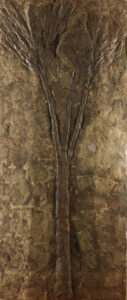The geological history of the area, from Eocene to Miocene is here retraced, showing the most significant fossils. At the center of the room there is the “fossil forest” of Castelgomberto found during excavations carried out by the Museum in 2004. There is also a recently donated outstanding fossil palm tree from Bolca, more than 2 m in height.
Among the many fossils on display there are sea urchins, corals, oyster shells, shark teeth, but also cuttlefish” bones”, a tadpole and a skeleton of the sirenid Prototherium, an aquatic mammal that lived in the coast feeding on water plants.
An extraordinary specimen both in size (almost 60 cm long!) and preservation is the gastropod mollusk Campanile giganteum. The size reached by this specimen indicate that the life conditions in the Eocene seas of the region (about 50 million years ago) had to be really optimal.
